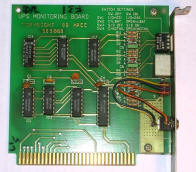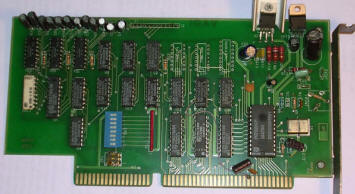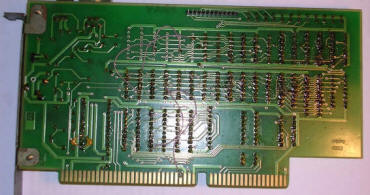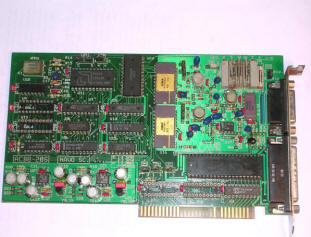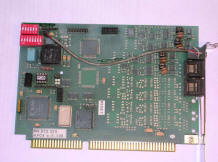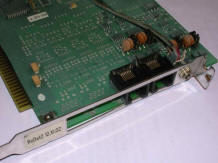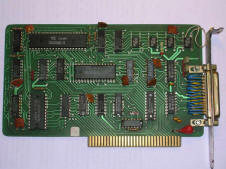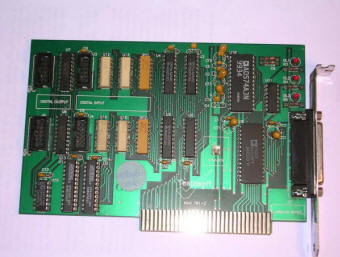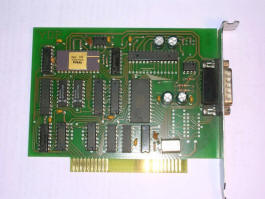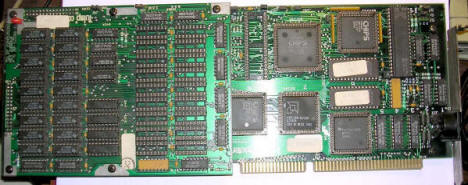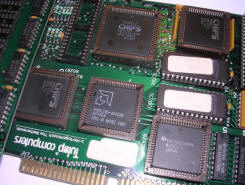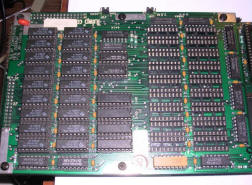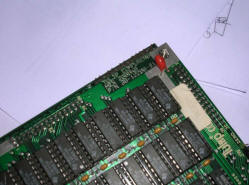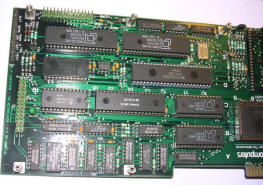Other boards
Personal Computer architecture became an industry standard. Since 1980s PCs became more andmore popular and their applications became wider and wider. Many applications required special expansions - to acquire data into a system, to interface with other devices or to add features not present in typical PC. Here are some of these boards shown. I don't know what most of these boards are exactly for and I'm still looking for information about them. My suspicions from analyzing of circuit are shown below.
HARPO KBD2
Harpo is a Polish company which makes different accessibility-related
computer accessories. Keyboards with specialized key arrangements, small
pointing devices to move cursor with one finger, or software speech
synthesizers. This way disabled people can use computers much easier.
And that's all I know. This 16-bit ISA board has been made by Harpo in
mid-1990s. It has TTL logic, jumper block and a complete acoustic
amplifier on a bit crudely-mounted heatsink, as well as unpopulated
space for 3.5mm-Jack socket. Instead, on the other side of the board, a
2-pin "Goldpin" connector is soldered through resistor, probably to use
PC speaker as output. Electrolytic capacitors are used to filter 12
digital inputs driving optocouplers and in their connector there is no
ground or power.
Another important chip is a PCF8200P circuit, which is a synthesizer
chip used to generate audio signal of speech parts. This way, with
consistent stream of data it is possible to generate speech.
The technology which was used to make this board is not advanced - it
rather looks like a prototype. There are numerous connections made with
wires on both sides of board, some chips are skipped and "patched" with
wires. The board has not been washed after soldering and the soldering
looks like it was done by hand.
I guess this board has been some product, maybe testing one, maybe a
small series, to make computer speak. The software for it has been
probably totally lost.
ReDat2
I got this board as "spare parts source", but I kept it to show how a
well-protected electronics looks like. These boards are used in larger
telecommunication systems to redirect, record or intercept
communication. In dispatch systems these boards can record all calls
happening simultaneously on phone line and classify them to dispatch
terminals. Similar solutions are used in air traffic control or military
equipment. This is a critical-security component which needs to maintain
proper operation all time.
This particular board is probably from 2002, made by Czech company
Redat. It was used to record 2 input phone lines to dispatch system -
all calls at once. However, there were versions of this board for 4
lines too.
Let's look how this board is made. There are almost no through-hole
components. The input stage is a set of SMD filters and amplifiers.
Next, we have a small chip, probably separator. The logic is implemented
using single XILINX chip and the other square chip is probably an ADC or
expander. Converted signals can then be recorded on a PC.
Because this board must work all time, it is protected a specific way -
a whole board except connectors and jumpers is painted with a thick and
hard enamel. It makes fixing of such board harder, but it also prevents
external conditions from damaging components and by bounding them to PCB
makes solder cracks less probable. Compare this to Polish telephone
dispatch system.
The manufacturer of this board still offers security systems as Retia.
Swedex BSC Board
According to text on board's surface, this one has been made by PPZ
SWEDEX, a Polish-foreign joint venture which was a popular form by the
end of 1980s in Poland... and was the only way to purchase larger
amounts of western components. Such company has been indeed registered
in 1985 and existed probably until 1994 as Swedex Universal. They were
making computer and telecommunication electronics, also modems.
According to the
partially available article the first Polish modem made
independently was 1200-baud unit called 1230P made by "Swedex Universal"
with cooperation with Swedish company TGC AB.
On board, we have 8255 parallel I/O, 8251 serial driver and 8253
probably as timebase generator for port driver. There are also 4 dual
RS232 line drivers. It indeed can be a 4-channel multiplexed multi-RS232
board, but its DB25 connector has some ordinary digital lines put too.
Part date codes allow to approximate its manufacturing date to 1987-88.
YDP ACCA 12/8
The company YDP is well known. In 1990 Young Digital Poland has been
registered as a company and they started to make software and hardware
for measurement systems, mostly acoustic. In mid-1990s they entered a
developing multimedia market with encyclopedias, dictionaries and
educational software on CD-ROMs. In 2000s they made a multimedia school
books on CDs, which was even an export product. YDP has been renamed to
Young Digital Planet then and in 2010 was acquired by German media
group.
This board is probably from such acoustic measurement systems. We have a
MDAC565 12-bit digital-to-analog converter and ADS574 analog-to-digital
converter, with accompanying electronics. Most digital I/O pins from a
15-pin male connector on the bracket end in unpopulated chip holes, only
analog output and input is connected with power. The chips date codes
are varied, usually situated in second half of 1990s.
| Vision Systems IDE Enhancer This board was used in computers with BIOS hard disk limitations. If BIOS doesn't allow to address more cylinders, heads or sectors/track than some limit, this board can override it. It auto-detects the proper values and makes controller use them. The only problem is that in some cases the problem is not in BIOS, but in controller itself. The only circuit is an EPROM there, containing the firmware and logic to put it under right address in system's memory map. |
 |
Tulip 286 mainboard on a board
This is a complete 286 computer on a 16-bit ISA board. It has 10MHz CPU,
640kB of RAM with possible expansion to even 2.6MB (with 18 21010
chips), keyboard controller (any AT keyboard fits there) and even NPU
expansion socket. I don't know in what type of computer it was used, but
it has a very primitive BIOS in two EPROM
chips.
I found one configuration to power up: In a blank ISA backplane (3
connectors), with large spaces between them (this is important), with
C/M jumpers in C position, the jumper under it in the same position, the
jumper under not set at all or in the same. This will boot and probably
ask about running DIAGNOSTICS.
The DIAGNOSTICS is a program on a floppy disk which acts as BIOS setup.
One more time: This is really sensitive about this system bus, it was
probably some way terminated on the original backplane. I tried another
risers with denser slots, more slots, slots with both sides, it doesn't
even beep there. To power it up, just 5V is needed but other boards may
require all ISA voltages.
Now the disk. Use a 16-bit ISA controller board with COM/LPT and FDD.
After connecting an FDD it won't boot from anything except a DOS
720K-formatted double-density disk, so it's needed to format at least
one - for diagnostics.
Here is a set of Tulip disks in form of files:
DIAG121N.EXE, DIAG207E.EXE and DIAG333I.EXE, as well as disk images made
from them. We need DIAG207E to detect this machine and introduce
settings.
The PC speaker is connected by two adjacent pins, not 4 as in most AT
PCs. There is a battery connector nearby, used to keep BIOS settings and
RTC running.
The hard disk must be one from the pre-defined lists. Contrary to easly
Award's BIOSes, it seeks to the last cylinder on start-up so if you
select drive with the same amount of heads and sectors, but larger of
cylinders your drive will hang. However, I haven't made it to run any
drive because it didn't wrote anything - the disks were detected and
read OK, while writing always ended like it was writing, but not. It's
not controller's fault, but probably some incompatibility between
standard controllers and BIOS.





